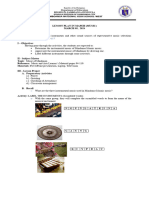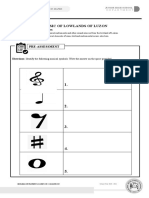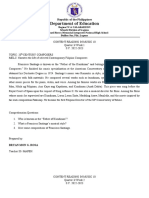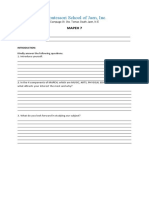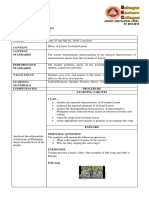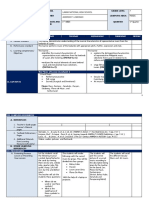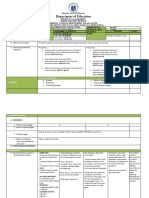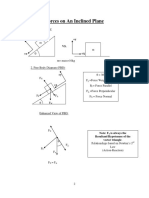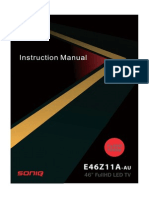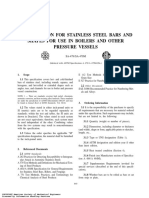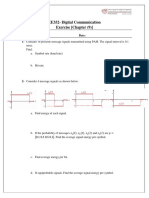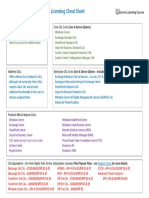4TH Competency Music
4TH Competency Music
Uploaded by
einjgotswagCopyright:
Available Formats
4TH Competency Music
4TH Competency Music
Uploaded by
einjgotswagOriginal Title
Copyright
Available Formats
Share this document
Did you find this document useful?
Is this content inappropriate?
Copyright:
Available Formats
4TH Competency Music
4TH Competency Music
Uploaded by
einjgotswagCopyright:
Available Formats
Republic of the Philippines
Department of Education
REGION IX, ZAMBOANGA PENINSULA
SCHOOLS DIVISION OF ZAMBOANGA CITY
ZAMBOANGA NATIONAL HIGH SCHOOL-WEST
LESSON PLAN IN MAPEH (MUSIC)
MARCH 7, 2024
Learning Competency
Improvises simple rhythmic/melodic accompaniments to selected music from Mindanao.
MU7LV-IIIc-h-5
I- Objectives
Having gone through the activities, the students are expected to:
A. Describe some of the simple rhythmic/melodic music from Mindanao.
B. Appreciate the music of Mindanao in using an improvised simple rhythmic/melodic.
C. Perform some of the improvised simple rhythmic/melodic accompaniments to selected music
from Mindanao.
II- Subject Matter
MUSIC OF MINDANAO
Reference: Grade 7 MUSIC and ARTS Learner’s Material, Modules
Materials: Laptop/LCD projector, Speaker, TV, Learners Module 7
III – Lesson Proper
A. Preparatory Activities
a) Prayer
b) Greeting
c) Checking of Attendance
d) Classroom management
B. Recall
ACTIVITY: Group Performance “IMPROVISE YOUR SOUND”
Directions: You might be wondering how it feels to play one of those instruments. To make it possible,
you are now tasked to look for available materials in your locality to improvise a kudyapi.
Materials:
String:
1. preferably no.2 guitar strings for the drone and no. 1 for the other string.
Fret:
1. an old meter stick or
2. a piece of wood preferably 4 to 5 cm wide and 2 cm thick or
3. any material that looks very close to the first two examples
Body:
1. empty bottle of 1.5 or 2 liters soft drink
2. Piece of bamboo tube about 1 foot
CRITERIA: SIMPLE MUSIC USING THE IMPROVISED MUSICAL INSTRUMENTS
Harmony, Rhythm, Melody - 40%
Timing/Beat - 30%
Overall Impact - 20%
Republic of the Philippines
Department of Education
REGION IX, ZAMBOANGA PENINSULA
SCHOOLS DIVISION OF ZAMBOANGA CITY
ZAMBOANGA NATIONAL HIGH SCHOOL-WEST
Group Behavior - 10%
100%
ANALYSIS
Is there a difference between electric instruments to improvised musical instruments in
creating simple music?
What is the importance of the rhythm or melody in creating simple music?
ABSTRACTION
Mindanao folk music includes the ancient Muslim folk song and dance called estijaro, and a Mindanao folk
song called uruyan. These are usually accompanied by drums, gongs, or other percussion instruments like the
tubing, gong.
Rhythm in music is a regular pattern of beats, sounds, or movements. It encompasses everything that relates
to time in music: namely meter, tempo, and pulse.
APPLICATION: “PLAYING THE SULING/KUDYAPI”
Directions: Perform this simple rhythmic pattern using your improvised instrument. You may opt to
memorize this as well for better playing. After playing the given rhythmic patterns, perform your
improvisation (adlib) of rhythmic patterns in a duple meter. Record your performances using your
cellphone or other media devices and submit it to your facilitator through messenger, e-mail, or other
media platforms.
EVALUATION: Rubrics in grading the performance.
Republic of the Philippines
Department of Education
REGION IX, ZAMBOANGA PENINSULA
SCHOOLS DIVISION OF ZAMBOANGA CITY
ZAMBOANGA NATIONAL HIGH SCHOOL-WEST
AGREEMENT:
o The students will be tasked to practice and memorize the songs “Zamboanga Hermosa”
“Biradalli” and “No Te Vayas” to perform next meeting.
Prepared by: Checked by:
THERESSE EDUARD E. HERMOSA MEILAN F. FALCATAN
Pre-Service Teacher Cooperating Teacher
Noted by:
BOYSIE A. SANTIAGO
SSHT IV, MAPEH Dept
You might also like
- Doctors NoteDocument3 pagesDoctors Notenanaikunga100% (1)
- 3RD Competency MusicDocument3 pages3RD Competency MusiceinjgotswagNo ratings yet
- 5TH Competency MusicDocument5 pages5TH Competency MusiceinjgotswagNo ratings yet
- Script - Instrumental Music in Mindanao G7 Q3 Week2Document10 pagesScript - Instrumental Music in Mindanao G7 Q3 Week2Jose Romel GrageraNo ratings yet
- 1ST Competency MusicDocument4 pages1ST Competency MusiceinjgotswagNo ratings yet
- DLL Music q1 g7Document6 pagesDLL Music q1 g7princess dimailigNo ratings yet
- 2ND Competency MusicDocument4 pages2ND Competency MusiceinjgotswagNo ratings yet
- Indian Mudic DLPDocument14 pagesIndian Mudic DLPPaul TanierlaNo ratings yet
- 2nd Q - WHLP MAPEH 10Document10 pages2nd Q - WHLP MAPEH 10Sherbeth DorojaNo ratings yet
- Grade 7 Non-Slamic Music DLPDocument14 pagesGrade 7 Non-Slamic Music DLPPaul TanierlaNo ratings yet
- College of Education: Isabela State UniversityDocument7 pagesCollege of Education: Isabela State UniversitySales, Jhohanna Lindsey EspinuevaNo ratings yet
- Music7 Q3 Wk1Document1 pageMusic7 Q3 Wk1Angelie Gentiles GupitaNo ratings yet
- Learning-Kit Music 7 Lesson 1Document4 pagesLearning-Kit Music 7 Lesson 1Nas LeeNo ratings yet
- Learning-Kit Music 7 Lesson 1Document4 pagesLearning-Kit Music 7 Lesson 1Nas LeeNo ratings yet
- Weekly Home Learning Plan: TuesdayDocument5 pagesWeekly Home Learning Plan: TuesdayMaricris LaudeNo ratings yet
- Q3 Las M1 Music10 WK1 2Document16 pagesQ3 Las M1 Music10 WK1 2bonzai guillena100% (1)
- Music7 Q1 Wk4Document3 pagesMusic7 Q1 Wk4BERNADETH CREDONo ratings yet
- Music 7 Las PinapugasanDocument7 pagesMusic 7 Las PinapugasanDonah Jedidiah Mae Sayo100% (1)
- Grade 7 Non-Slamic Performance TaskDocument3 pagesGrade 7 Non-Slamic Performance TaskPaul TanierlaNo ratings yet
- Daily Instructional Plan: Grade/ Year: 7 Subject Area: MAPEH (MUSIC) Date: 07/22/2019Document3 pagesDaily Instructional Plan: Grade/ Year: 7 Subject Area: MAPEH (MUSIC) Date: 07/22/2019Agnes Angeles100% (1)
- College of Education: Isabela State UniversityDocument8 pagesCollege of Education: Isabela State UniversitySales, Jhohanna Lindsey EspinuevaNo ratings yet
- LP Music Q2Document10 pagesLP Music Q2Grace JabolinNo ratings yet
- Lesson Plan 3 - Song ComposerDocument4 pagesLesson Plan 3 - Song ComposerBrenon RomeroNo ratings yet
- Magsaysay Ave. Karangalan Village, Manggahan Pasig CityDocument5 pagesMagsaysay Ave. Karangalan Village, Manggahan Pasig CityJamie FernandezNo ratings yet
- Letter RequestDocument3 pagesLetter RequestSean Edward SaludarNo ratings yet
- Lesson Plan Music 7Document4 pagesLesson Plan Music 7Shamaica SurigaoNo ratings yet
- Weekly Home Learning Plan: Grade 10 (Mapeh)Document1 pageWeekly Home Learning Plan: Grade 10 (Mapeh)Jean Antoniet Acopiado LegadosNo ratings yet
- Mambayaan Integrated School Mambayaan Integrated School Jennelyn G. MalaynoDocument35 pagesMambayaan Integrated School Mambayaan Integrated School Jennelyn G. Malaynojennelyn malaynoNo ratings yet
- College of Education: Isabela State UniversityDocument10 pagesCollege of Education: Isabela State UniversitySales, Jhohanna Lindsey EspinuevaNo ratings yet
- LP Mapeh 7Document16 pagesLP Mapeh 7BIT INTERNATIONAL COLLEGE TALIBON100% (1)
- Music-7 (W4) MapehDocument3 pagesMusic-7 (W4) MapehJhuny VarcaNo ratings yet
- 10 Music: Quarter 3 - Module 1-4 Contemporary Philippine MusicDocument16 pages10 Music: Quarter 3 - Module 1-4 Contemporary Philippine MusicMarvin TorreNo ratings yet
- Cot 2 Music 4th QuarterDocument4 pagesCot 2 Music 4th QuarterEliza Jane Miguel VillanuevaNo ratings yet
- Enrichment Music 7 2021 2022Document2 pagesEnrichment Music 7 2021 2022Loniza ManceNo ratings yet
- Content Reading in Music 10Document6 pagesContent Reading in Music 10Bryan Mon RosaNo ratings yet
- 1stQ To 4thQ Leastlearned MUSICDocument13 pages1stQ To 4thQ Leastlearned MUSICHelen VirtucioNo ratings yet
- Department of Education: Republic of The PhilippinesDocument8 pagesDepartment of Education: Republic of The PhilippinesShella maezingNo ratings yet
- Music: Quarter 3 - Module 2Document9 pagesMusic: Quarter 3 - Module 2Dyanne De JesusNo ratings yet
- Cot 1 - MusicDocument9 pagesCot 1 - Musiccristele rein gonzalesNo ratings yet
- Food Processing Lesson ExemplarDocument4 pagesFood Processing Lesson ExemplarLarren Joy TumpagNo ratings yet
- SDLP W1Document4 pagesSDLP W1Jhon Cecille R. SanicoNo ratings yet
- Mapeh Grade 7 Quarter 3: Learning Module Notre Dame of Pigcawayan, Inc. SY 2020-2021Document11 pagesMapeh Grade 7 Quarter 3: Learning Module Notre Dame of Pigcawayan, Inc. SY 2020-2021Elmor SanchezNo ratings yet
- Music7.q1.w6-8.book, Joy P.Document7 pagesMusic7.q1.w6-8.book, Joy P.Daniezhel CañeteNo ratings yet
- Montessori School of Jaen, Inc.: Mapeh 7Document6 pagesMontessori School of Jaen, Inc.: Mapeh 7Hazel MirandaNo ratings yet
- Learning Activity Sheet Final Grade 7Document4 pagesLearning Activity Sheet Final Grade 7Joseph Eric NardoNo ratings yet
- Music (3 4th)Document8 pagesMusic (3 4th)Janille RepullezaNo ratings yet
- Grade 7-Q1-Music-Learners Progress ReportDocument8 pagesGrade 7-Q1-Music-Learners Progress ReportERNALYN GEM GEM G. RAFER-PANDINo ratings yet
- Detailed Lesson Plan Palawan MusicDocument7 pagesDetailed Lesson Plan Palawan MusicJoy AlviorNo ratings yet
- WLP Music Week 8Document4 pagesWLP Music Week 8Donna Mae KatimbangNo ratings yet
- Grade 8 Music July 1st WeekDocument4 pagesGrade 8 Music July 1st WeekMar Gauden Francisco Aceron100% (1)
- Teacher: Lyka S. Gonzales Subject: MUSIC (GRADE 7)Document4 pagesTeacher: Lyka S. Gonzales Subject: MUSIC (GRADE 7)Lyka GonzalesNo ratings yet
- IPT1 MAPEH10 Q4-FinalDocument2 pagesIPT1 MAPEH10 Q4-FinalMark Glenn ApeNo ratings yet
- Music 7: Learning Activity Sheet Music of The Cordillera, Mindoro, Palawan and The VisayasDocument4 pagesMusic 7: Learning Activity Sheet Music of The Cordillera, Mindoro, Palawan and The VisayasZaldy Roman MendozaNo ratings yet
- Music 7 Lesson Exemplar (Food Processing Intergation)Document5 pagesMusic 7 Lesson Exemplar (Food Processing Intergation)Larren Joy TumpagNo ratings yet
- Moscoso-Rios National High School Weekly Home Learning Plan (Grade 8-Mapeh)Document2 pagesMoscoso-Rios National High School Weekly Home Learning Plan (Grade 8-Mapeh)KD MagbanuaNo ratings yet
- Q1 Grade 7 Music DLL Week 2Document7 pagesQ1 Grade 7 Music DLL Week 2Andrew LomongoNo ratings yet
- Q1 Grade 7 Music DLL Week 2Document6 pagesQ1 Grade 7 Music DLL Week 2Raven PanganibanNo ratings yet
- MAPEH X Music W8Q2 Rafer, Aira JoyDocument2 pagesMAPEH X Music W8Q2 Rafer, Aira Joysusan pajarilloNo ratings yet
- Music: Quarter 3 - Module 2: Contemporary Philippine Music (Student's Performance)Document16 pagesMusic: Quarter 3 - Module 2: Contemporary Philippine Music (Student's Performance)Romeo Avancena100% (3)
- Can Emu Really Sing Jambo?: ¿Puede Emu Cantar Realmente Jambo?From EverandCan Emu Really Sing Jambo?: ¿Puede Emu Cantar Realmente Jambo?No ratings yet
- Combinatorics Handout # 7: 1 ProblemsDocument2 pagesCombinatorics Handout # 7: 1 ProblemsWalker KroubalkianNo ratings yet
- Inclined PlanesDocument7 pagesInclined PlanesBradley ChisolmNo ratings yet
- LS PrePost Intro 2013 03Document245 pagesLS PrePost Intro 2013 03Hamed MemarianNo ratings yet
- ConsolidatedStatementReport Aug2022Document2 pagesConsolidatedStatementReport Aug2022pp1560078No ratings yet
- Soniq Operating Manual E46Z11ADocument55 pagesSoniq Operating Manual E46Z11AAllan WilliamsNo ratings yet
- FAA Vendor Training InformationDocument33 pagesFAA Vendor Training InformationJunk MailNo ratings yet
- Math F4C7 Graphs of Motion - Phase Three '23Document19 pagesMath F4C7 Graphs of Motion - Phase Three '23sachveenNo ratings yet
- Part - A: Bangladesh Marine Academy, ChittagongDocument2 pagesPart - A: Bangladesh Marine Academy, ChittagongXahid HasanNo ratings yet
- Specification For Stainless Steel Bars and Shapes For Use in Boilers and Other Pressure VesselsDocument13 pagesSpecification For Stainless Steel Bars and Shapes For Use in Boilers and Other Pressure VesselsjscfNo ratings yet
- Test Bank Lesson 7 - Understanding Wide Area NetworksDocument6 pagesTest Bank Lesson 7 - Understanding Wide Area NetworksmeixfuuNo ratings yet
- Incentive Week 23-24Document12 pagesIncentive Week 23-24Pratiksha KumariNo ratings yet
- Job Interview Common QuestionsDocument3 pagesJob Interview Common QuestionsYOONGINo ratings yet
- Module 3 MergedDocument80 pagesModule 3 MergedSARANSH PRAJAPATI 22BCE10795No ratings yet
- Demi Winner X Ble: Demi Left Demi RightDocument1 pageDemi Winner X Ble: Demi Left Demi RightTu Do100% (2)
- Jennifer Letter 1Document1 pageJennifer Letter 1api-316030498No ratings yet
- Attachment 1Document21 pagesAttachment 1anthony.onyishi.242680No ratings yet
- World of Knowledge Yr 4 KSSR 2014Document6 pagesWorld of Knowledge Yr 4 KSSR 2014Kazhimah HanaNo ratings yet
- 1 Zonas NeurovascularesDocument7 pages1 Zonas NeurovascularesUrsus LópezNo ratings yet
- Sqa PlanDocument4 pagesSqa PlanNaga Tej DasariNo ratings yet
- MS CAL Licensing Cheat SheetDocument1 pageMS CAL Licensing Cheat SheetbitoogillNo ratings yet
- A Planting Template For Plug FlatsDocument2 pagesA Planting Template For Plug FlatsMario Gerardo Garcia RiosNo ratings yet
- Aia Kellyville - Hpe - YrDocument3 pagesAia Kellyville - Hpe - Yrapi-434420410No ratings yet
- Standout Mixes ChecklistDocument3 pagesStandout Mixes ChecklistAndy ferrisNo ratings yet
- 1367 2692 1 SMDocument28 pages1367 2692 1 SMWahyu Sekar WijayaningtyasNo ratings yet
- Star Fleet Command Manual - Volume XIIIDocument464 pagesStar Fleet Command Manual - Volume XIIIEndre Bujtas100% (1)
- CV and Coverletter PHDDocument4 pagesCV and Coverletter PHDKhurram Shahzad QureshiNo ratings yet
- X-Tite EpoxyGrout 150 - Job - 20220913Document3 pagesX-Tite EpoxyGrout 150 - Job - 20220913jasonNo ratings yet
- MAN Combustion ChamberDocument2 pagesMAN Combustion ChamberJayesh Nayakanti100% (1)
- ERGONOMIC RELATED DISEASES-compressedDocument21 pagesERGONOMIC RELATED DISEASES-compressedChrist Wesley Bernard SagalaNo ratings yet






